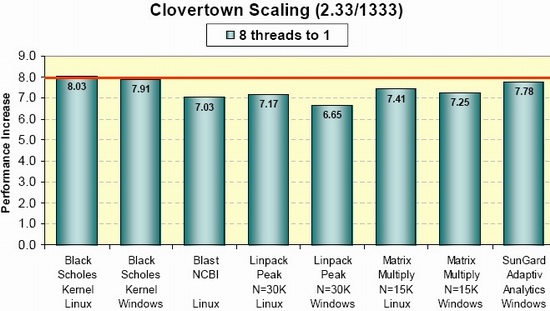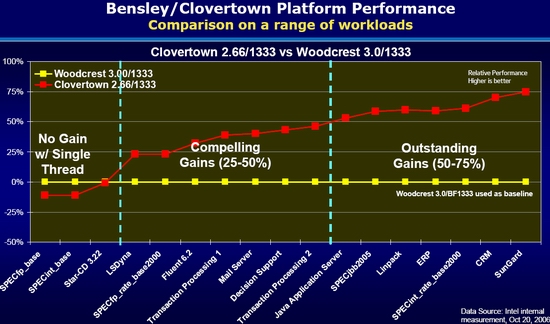Quad Core Intel Xeon 53xx Clovertown
by Johan De Gelas on December 27, 2006 5:00 AM EST- Posted in
- IT Computing
Analysis
When it comes to power consumption numbers, we could only compare the quad core Xeon with the dual core one. Our Opteron platform was too different to make such comparisons meaningful. In Specjbb2005, the Clovertown machine consumed about 20 to 40 Watt more, which is about 8 to 15 percent. If you want to compare the Xeon with the Opteron platform, check out Jason and Ross' testing here.
Let us summarize what we have learned so far. Thanks to the very competitive price, the new quad core Xeon is in many applications a winner when it comes to price/performance: a dual socket server is a lot cheaper than a quad socket model and a 2.33GHz quad core Xeon costs the same as a dual core Xeon 5160. Despite the very aggressive price setting and the excellent per socket performance, the newest Xeon is not unbeatable, a result of mediocre scaling.
To put everything in perspective, you can never give enough benchmarking numbers. Let us see what Intel's own benchmarking tells us. First Intel shows off some benchmarks which really demonstrate fantastic scaling moving from one core to eight.

Eight benchmarks which scale excellent makes for a very nice chart, but in reality we are only looking at three different benchmarks. Blast, Linpack and matrix multiplies can all be categorized as matrix multiply benchmarks. Scholes and Sungard ACR use different algorithms, but both are products of Sungard and both are used in the financial world. They have a high value to financial analysts who use these tools, and complete our analysis. We found that per socket, the quad core Xeon offers about twice the performance of the dual Opteron per socket, and about 10% per core (Octal core 2.33GHz Xeon versus 2.4GHz octal Opteron). So yes, there are applications out there where a "Clovertown" Xeon is a huge step forward. The question is how common are these situations? Intel seems to have anticipated this question and the performance group of Portland presented a very interesting slide.

Notice that Intel uses a 120W TDP 2.66GHz quad core Xeon and not the 2.33GHz we tested. Considering that everybody - including Intel - agrees that we should go for maximum performance/watt, we would chose the 2.33GHz instead, as it has the same TDP as the Xeon 5160 3GHz which is used as baseline. This means that we have to subtract about 13% of the performance figures if we want to keep the TDP the same, and in that case some of the "compelling gains" are no longer really tangible. So we can conclude that CRM, Financial analysis, ERP and Java applications are the best applications for our Clovertown Xeon. For rendering, transaction processing, and especially structural simulation (LS Dyna) and flow modeling (fluent) the picture is a lot less clear.
When it comes to power consumption numbers, we could only compare the quad core Xeon with the dual core one. Our Opteron platform was too different to make such comparisons meaningful. In Specjbb2005, the Clovertown machine consumed about 20 to 40 Watt more, which is about 8 to 15 percent. If you want to compare the Xeon with the Opteron platform, check out Jason and Ross' testing here.
Let us summarize what we have learned so far. Thanks to the very competitive price, the new quad core Xeon is in many applications a winner when it comes to price/performance: a dual socket server is a lot cheaper than a quad socket model and a 2.33GHz quad core Xeon costs the same as a dual core Xeon 5160. Despite the very aggressive price setting and the excellent per socket performance, the newest Xeon is not unbeatable, a result of mediocre scaling.
To put everything in perspective, you can never give enough benchmarking numbers. Let us see what Intel's own benchmarking tells us. First Intel shows off some benchmarks which really demonstrate fantastic scaling moving from one core to eight.

Eight benchmarks which scale excellent makes for a very nice chart, but in reality we are only looking at three different benchmarks. Blast, Linpack and matrix multiplies can all be categorized as matrix multiply benchmarks. Scholes and Sungard ACR use different algorithms, but both are products of Sungard and both are used in the financial world. They have a high value to financial analysts who use these tools, and complete our analysis. We found that per socket, the quad core Xeon offers about twice the performance of the dual Opteron per socket, and about 10% per core (Octal core 2.33GHz Xeon versus 2.4GHz octal Opteron). So yes, there are applications out there where a "Clovertown" Xeon is a huge step forward. The question is how common are these situations? Intel seems to have anticipated this question and the performance group of Portland presented a very interesting slide.

Notice that Intel uses a 120W TDP 2.66GHz quad core Xeon and not the 2.33GHz we tested. Considering that everybody - including Intel - agrees that we should go for maximum performance/watt, we would chose the 2.33GHz instead, as it has the same TDP as the Xeon 5160 3GHz which is used as baseline. This means that we have to subtract about 13% of the performance figures if we want to keep the TDP the same, and in that case some of the "compelling gains" are no longer really tangible. So we can conclude that CRM, Financial analysis, ERP and Java applications are the best applications for our Clovertown Xeon. For rendering, transaction processing, and especially structural simulation (LS Dyna) and flow modeling (fluent) the picture is a lot less clear.










15 Comments
View All Comments
Antinomy - Wednesday, March 7, 2007 - link
A great review, very interesting.But there are a few things to mention. A mistake in results of Cinebench test. In the overall table the uni Clovertown system got 1272 points, but in the next (per core performance) - 1169. The result was swapped with the one of Xeon 7130. And a comment about the scalability extrapolation. The result of scalability 2.33 Clover vs 3.0 Dual Woodcrest can be hardly compared due to different organization of the systems. These MoBo have two independent FSB so this means, that the two Woodcrests will be provided with twice more peak memory bandwith. This can't make no influence on the result. Also the 4 channel memory mode provides a 5% increase versus 2 channel in real bandwith, so we can't say that theese applications do not suffer from lack of memory bandwith.
It would be interesting to provide a test of uni Woodcrest system and a test of system based on Woodcrest (both uni and dual) at the same frequency as Clovertown has. And a Kentsfield\Conroe systems (despite they aren't server ones) would be nice to look at because of their more efficient usage of memory bandwith and FSB.
afuruhed - Thursday, December 28, 2006 - link
We are getting more Clovertowns. There is a chart at http://www.pantor.com/software.html">pantor.com that indicates that some applications benefit a lot. http://en.wikipedia.org/wiki/FIX_protocol">The FIX protocol is a technical specification for electronic communication of trade-related messages (financial markets).henriks - Thursday, December 28, 2006 - link
Agree with other responses - good article!Some comments on the jbb results page:
You state that JRockit is (only) available for x86-64 and Itanium. x86 and Sparc should be added to this list.
The JRockit configuration you're using enables a single-spaced GC. In that configuration, performance is tied to heap size (larger heap means fewer GC events). Increasing the heap size to 3 GB - as for the Sun benchmark results - would increase performance slightly but in particular give much better scalability when you increase the number of warehouses to large numbers.
It looks like you have not enabled large pages in the OS. Doing this would give a large performance boost and help scalability regardless of chip or JVM vendor.
Astute readers may note that your results are lower than the published results on www.spec.org. Apart from OS and possibly BIOS tuning, the reason is that the most recent results are using a newer JRockit version (not yet available for public download). This new version improves performance on this benchmark by 20-30% on x86 chips - Intel *and* AMD - with the largest positive effect on high-bin chips from the respective vendors. The effect on other Java applications vary from zero to a lot.
Cheers!
Henrik, JRockit team
dropadrop - Wednesday, December 27, 2006 - link
Considering how much we just payed for some DL585's compared to DL380's I think the performance is pretty impressive. There is still something the DL380's (and most other two socket servers) can't do, and that is hosting 64GB or more ram.I mainly take care of vmware servers, and there the amount of memory becomes a bottleneck long before the processors, atleast in most setups. I don't think I'd have alot of use for octal processors unless I got a minimum of 32GB of ram, probably 64.
rowcroft - Thursday, December 28, 2006 - link
I've run into the same challenge when planning for the quads. My take is that I'm getting dual quads for half the price of quad dual cores. With ESX 3's HA functionality I can group the host servers and get the 32GB of ram with double the cores and have host based redundancy for critical vm's.mino - Thursday, December 28, 2006 - link
there is another thing DL380 lacks: no drop-in analog to Barcelona on the horizon...Justin Case - Wednesday, December 27, 2006 - link
Finally a good article at AT, written by someone who knows what he's talking about. Meaningful benchmarks, meaningful comments, and conclusions that make sense. If only some Johanness could rub off on other AT writers...hans007 - Wednesday, December 27, 2006 - link
i think an alternative to say a dual dual core AMD though even as a server or workstation is say a quad core socket 775 cpu. I know the lower 3xxx series xeons are made for this (and are exactly the same as core 2 duo) soyou could do a comparison of 2 amd dual cores vs a single 775 quad with ECC ddr2 etc.
mino - Thursday, December 28, 2006 - link
Check QuadFX vs. Kentsfield reviews.With ECC both results will be a bit lower but the conparison remains.
A small hint: NO ONE tested QuadFX as DB server against Kenstfield....
Gues what: Quad FX is cheaper and would rules the roost on server-like tasks.
ltcommanderdata - Wednesday, December 27, 2006 - link
Well it's nice to finally see a review of the 5145, although I was hoping for more detailed power consumption numbers. The performance benchmarks were very detailed though which was great.Thought I would point out a few errors I noticed as I was flipping through. First on page 2, in the Cache2Cache Latency chart the 201 for the Xeon DP 5060 that is placed in the "Same die, same package" row should be in the "Different die, same package" row. Dempsey uses a dual die approach like Presler and Cloverton as opposed to a single die approach like Smithfield and Paxville DP. And in the last page in the conclusion, you mentioned Clarksboro having "four DIBs", which implies 8 FSBs. I believe that should read two DIBs or really a Quad Independent Bus (QIB) since I'm pretty sure it only has 4 FSBs. (On a side note, Intel slides showed those 4 FSBs clocked at 1066MHz which is really disappointing. Hopefully, now that Cloverton turns out to come in 1333MHz versions instead of only 1066MHz versions that was first announced, Tigerton (and therefore Clarksboro) which is based on Cloverton will also have 1333MHz versions.)